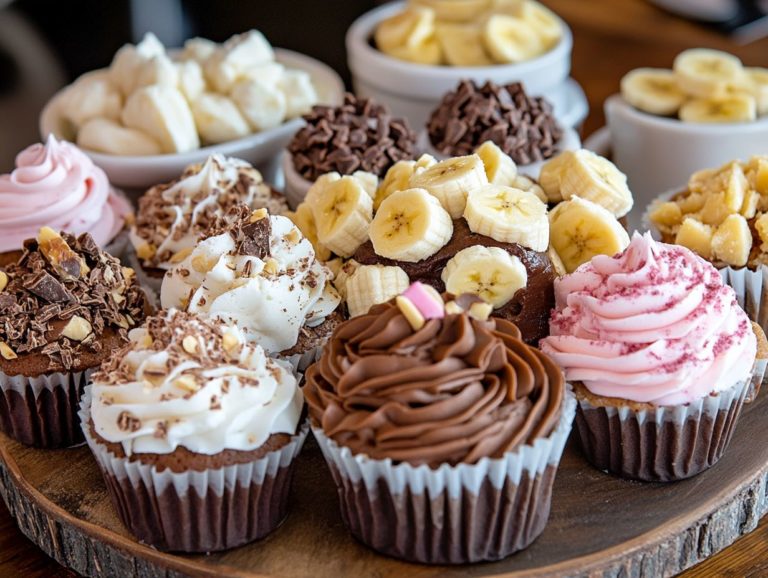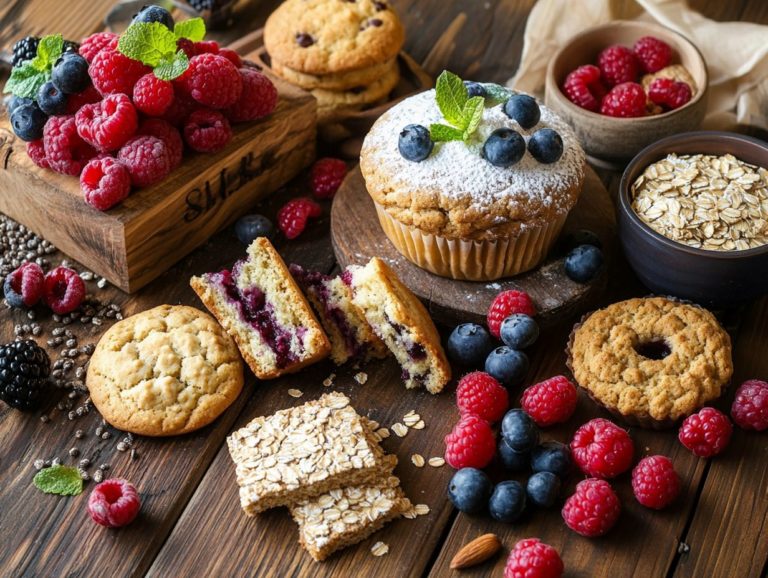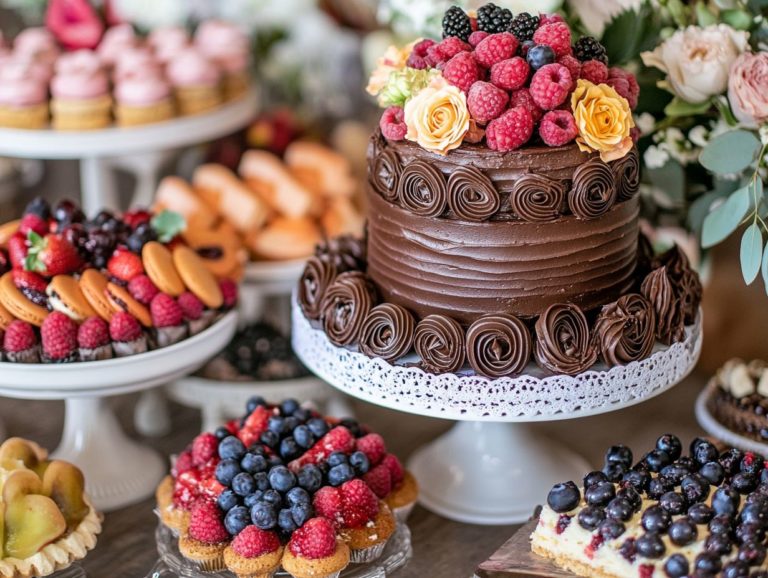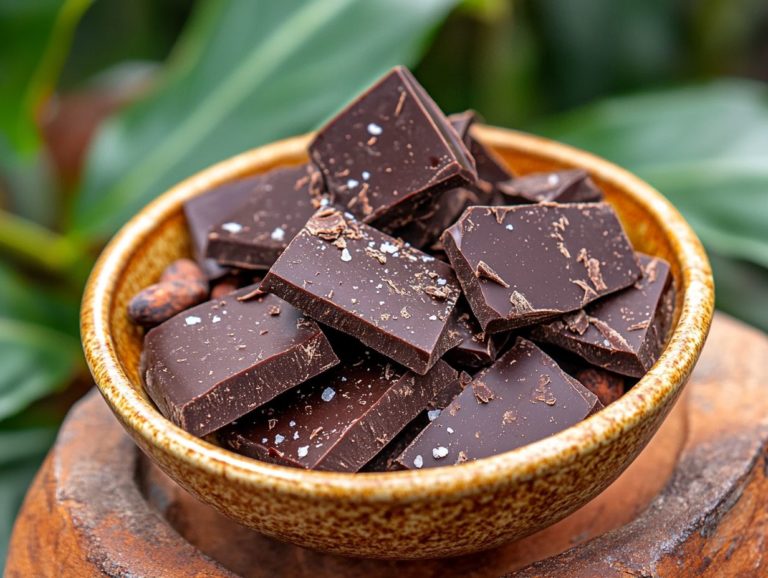How to Make Desserts Safe for Allergies?
Food allergies affect millions of people, underscoring the importance of understanding their implications, especially when it comes to delightful treats. Dive in and discover how you can create delicious treats that everyone can enjoy!
This article delves into the nature of food allergies, highlighting the most common allergens and their associated symptoms. This includes the alarming signs of severe reactions, which can be life-threatening, such as anaphylaxis.
You’ll find practical tips for crafting safe, allergy-friendly desserts, accompanied by tempting recipes to try. Whether you’re hosting a gathering or simply looking to indulge without worry, this guide is designed to meet your needs.
Contents
- Key Takeaways:
- What Are Food Allergies?
- What Are the Symptoms of Food Allergies?
- How to Make Desserts Safe for Allergies?
- 4. Inform Guests of Allergen-Free Options
- 5. Have an Allergy-Free Dessert Station
- What Are Some Allergy-Friendly Dessert Recipes?
- Frequently Asked Questions
- 4. Be Prepared for Emergencies
- What are the most common food allergies to consider when making desserts?
- How can I ensure my desserts are safe for all allergies?
- What are some tips for preventing cross-contamination in dessert preparation?
- Are there any alternative ingredients I can use in desserts to accommodate allergies?
- Is it important to label desserts that are safe for allergies?
- Can I still make delicious desserts while accommodating allergies?
Key Takeaways:

- Read ingredient labels carefully to avoid using allergens in your desserts.
- Prevent cross-contamination by using separate utensils and equipment for allergy-friendly desserts.
- Inform guests of your allergen-free options and have a designated dessert station for allergy-friendly treats.
What Are Food Allergies?
Food allergies are a pressing concern today. They impact millions, including children, and can lead to severe reactions when certain ingredients are consumed.
These allergies arise when the immune system mistakenly perceives a normally harmless substance like nuts, gluten, or dairy as a threat. This reaction can lead to symptoms that vary from mild discomfort to life-threatening situations.
By gaining a deeper understanding of food allergies, you can foster safe environments and create offerings that cater to everyone s needs, including delightful allergy-friendly desserts that allow all to indulge without apprehension.
What Are the Most Common Food Allergies?
The most common food allergies, including gluten, dairy, nuts, eggs, soy, and seafood, present unique challenges. Understanding these allergies is essential for curating safe and enjoyable dining experiences, particularly when it comes to desserts that accommodate various dietary restrictions.
Gluten
Managing gluten allergies involves creating delightful gluten-free options that everyone can enjoy.
Dairy
For those with dairy allergies, using alternatives like almond milk can make beloved desserts more accessible.
Nuts
Managing nut allergies can involve exploring alternative toppings or fillings, allowing for creativity without compromising safety.
By recognizing and thoughtfully addressing these allergies, you can transform traditional recipes into delightful dairy-free or gluten-free alternatives that everyone can savor.
This level of awareness fosters a communal atmosphere where sweet treats can be shared and enjoyed, ensuring that food allergies do not become a barrier to delight.
What Are the Symptoms of Food Allergies?
Food allergy symptoms can vary significantly, ranging from mild reactions like hives and itching to severe cases such as anaphylaxis, which demands immediate medical attention.
Being aware helps you identify safe ingredients and steer clear of potentially dangerous situations when preparing meals and desserts. Your vigilance can make a difference in ensuring a safe dining experience.
What Are the Symptoms of Anaphylaxis?
Anaphylaxis is a severe and potentially life-threatening allergic reaction that can occur rapidly upon exposure to certain allergens, such as peanuts or shellfish. Symptoms may include difficulty breathing, throat swelling, a rapid pulse, and even loss of consciousness. Immediate treatment is crucial for safety.
Recognizing these symptoms is vital, as they can escalate quickly, potentially leading to shock or even death if not addressed promptly. Triggers for anaphylaxis can vary widely, from insect stings and medication reactions to food allergies and exercise-induced responses.
It s essential to have an emergency plan in place if you re at risk. This plan should include carrying an epinephrine auto-injector and training your friends and family on how to use it. Such preparedness not only reduces panic during an acute episode but also significantly increases your chances of surviving an allergic emergency, highlighting the serious nature of this health risk.
How to Make Desserts Safe for Allergies?
Creating desserts that are safe for individuals with food allergies demands meticulous attention and thoughtful planning. It s essential to ensure that every ingredient is allergy-friendly and suitable for everyone at the table, especially the little ones.
By adhering to straightforward guidelines such as diligently reading ingredient labels, preventing cross-contamination, and opting for alternative ingredients you can craft delightful treats that everyone can savor without the worry of allergic reactions.
1. Read Ingredient Labels Carefully
Reading ingredient labels carefully is essential when you’re preparing food for individuals with food allergies. This practice not only helps you identify allergens but also ensures the safety of the ingredients you use. It becomes even more crucial when you re baking desserts like cookies, cakes, or any indulgent treats that demand precise knowledge of every element going into the final product.
Understanding the specific allergens present in your ingredients is vital for preventing serious reactions. Keep an eye out for common culprits such as gluten, nuts, dairy, and eggs, which can often be lurking in processed foods, waiting to surprise you.
It s wise to seek verified gluten-free, vegan, and allergy-friendly options from reputable sources, like dedicated health food stores or certified websites. Many brands are now catering to specific dietary needs, offering safe and delicious alternatives that everyone can enjoy.
By prioritizing this careful scrutiny, you can create delightful treats that everyone can savor without worry, fostering an inclusive atmosphere at any gathering.
2. Avoid Cross-Contamination

Avoiding cross-contamination is crucial in food preparation, especially when you’re working with allergy-friendly recipes. You want to ensure that even the tiniest trace of allergens doesn’t jeopardize the safety of your final dish. Achieve this by using separate utensils and surfaces for your desserts and being mindful of any shared equipment.
By designating specific cutting boards, mixing bowls, and measuring cups solely for allergen-free dishes, you can significantly minimize the risk of accidental exposure. It s wise to meticulously clean all surfaces and utensils between handling different ingredients. For example, if you’ve just stirred nuts with a spoon, a thorough wash before moving on to chocolate will keep those pesky allergens from sneaking in.
Storing your ingredients in clearly labeled containers also helps maintain organization and clarity during preparation, making it easier to sidestep any potential cross-contact. Ultimately, by adopting these practices, you not only protect those with food allergies but also elevate the overall food safety in your kitchen.
3. Use Alternative Ingredients
Using alternative ingredients is a simple yet effective method to craft desserts that are safe for those with food allergies, providing delightful options without compromising on flavor or texture. For instance, when you swap traditional flours for gluten-free varieties or replace dairy with plant-based alternatives, you’ll discover indulgent treats that cater to a wide range of dietary needs.
A popular substitution is opting for almond flour or oat flour instead of wheat flour. This not only enhances the nutty flavor but also adds a delightful moisture to your baked creations. When a recipe calls for milk, consider using almond milk, coconut cream, or cashew milk. These alternatives deliver a creamy texture that perfectly aligns with a dairy-free diet.
Such substitutions guarantee that your baked goods maintain a rich taste and satisfying mouthfeel, proving that allergy-friendly baking can be just as enjoyable as traditional methods. The secret lies in experimenting with these ingredients while keeping an eye on the balance of flavors and textures, allowing everyone to relish a sweet moment without concern.
4. Inform Guests of Allergen-Free Options
Informing your guests about allergen-free options at your gathering is crucial for creating an environment where everyone feels safe and included, especially kids with food allergies.
Clearly communicating which desserts are allergy-friendly can prevent confusion and foster a welcoming atmosphere. Utilize signage or menu labels to highlight these options, enhancing transparency and enabling your guests to make informed choices.
When curating your dessert menu, consider a diverse selection that caters to various dietary restrictions, such as gluten-free or nut-free desserts. Collaborating with local bakeries that specialize in allergen-friendly treats can enrich the variety you offer, making it easier to accommodate those with food allergies.
Engaging in conversations with your guests before the event helps identify specific needs, ensuring that every sweet tooth is satisfied while prioritizing safety and inclusivity for all attendees. This thoughtful approach makes your event a hit among people with dietary restrictions, allowing them to enjoy delicious treats worry-free.
5. Have an Allergy-Free Dessert Station
Setting up an allergy-free dessert station offers a delightful and practical way to ensure everyone at your event can enjoy safe dessert options, particularly those with food allergies.
This station can include a range of baked goods, such as cookies, brownies, and cupcakes made from simple ingredients. Clearly labeling each dessert and providing a variety of choices creates an inviting atmosphere for all your guests.
This approach also allows you to showcase healthy treats like vegan desserts and plant-based options, ensuring no one feels left out. Consider adding allergen-free cakes or cupcakes made from alternative ingredients such as almond flour or coconut, which are perfect for those who prefer healthy desserts.
Presentation matters, so use vibrant platters and stylish labels to elevate your display and attract attention. You can even feature labels from popular allergy-friendly recipe blogs like Minimalist Baker and Mama Shire.
Include a comprehensive ingredient list for each item, clearly highlighting common allergens to eliminate confusion. Offering non-sweet options like yogurt parfaits with allergy-friendly granola can satisfy those who prefer savory treats.
Consider adding rice pudding or fruit sorbet for a diverse selection of safe and delicious options. This thoughtful approach ensures that every attendee feels included and can indulge without worries.
What Are Some Allergy-Friendly Dessert Recipes?
Allergy-friendly dessert recipes present a wonderful opportunity to indulge your sweet tooth without the stress of allergens. Imagine savoring options like gluten-free chocolate chip cookies, vegan strawberry cheesecake, and nut-free brownies, all crafted with care to meet your needs.
These treats ensure that everyone, from kids to adults, can enjoy a special occasion without worry. These recipes are designed to be both easy and enjoyable to create, ensuring everyone can safely join in on the delightful experience of dessert.
With inspirations from blogs like Choosing Chia and The Fit Cookie, you ll have an array of easy recipes at your fingertips. Try these delicious recipes at your next gathering and ensure everyone has a delightful experience!
1. Gluten-Free Chocolate Chip Cookies
Gluten-Free Chocolate Chip Cookies are a delightfully simple treat that you can enjoy without compromise, even if you have gluten sensitivities. With straightforward ingredients like almond flour and dairy-free chocolate chips, these cookies are sure to wow your guests at any party or gathering. These kid-friendly treats make for a perfect healthy yet indulgent option.
Their irresistible blend of buttery richness and sweet, chocolatey goodness allows the gluten-free version to stand toe-to-toe with its traditional counterpart in both flavor and texture. This makes them a real crowd-pleaser at any event.
To craft this ultimate indulgence, gather the following simple ingredients:
- Coconut oil or unsalted butter
- Vanilla extract
- Eggs
- A blend of gluten-free flours
The preparation is a breeze: cream the butter and sugars, mix in the eggs, and gradually fold in the dry ingredients. This no-bake recipe is as easy as it is rewarding. Bake these delectable treats for about 10-12 minutes, or until the edges turn a lovely golden brown, ensuring the center remains slightly soft for that fresh-from-the-oven experience.
Before they cool, don t forget to sprinkle a pinch of sea salt on top; it enhances the chocolatey flavor and makes each bite memorably delicious. For extra flair, try incorporating dark chocolate ginger tart for a twist.
2. Vegan Strawberry Cheesecake
Vegan Strawberry Cheesecake is a truly delightful and creamy dessert that highlights the natural sweetness of strawberries. It is entirely plant-based and allergy-friendly. This cake is not only vegan but also gluten-free, making it a versatile treat for all. With a crust crafted from nuts and dates, this dessert is delicious and nutritious, making it an ideal choice for both kids and adults. Recipes from blogs like Go Dairy Free and Allergy Awesomeness can provide further inspiration.
This scrumptious treat also accommodates a variety of dietary restrictions, as it is free from dairy, eggs, and gluten. This offers you a guilt-free indulgence that everyone can relish. The rich, velvety filling is made from soaked cashews, delivering that creamy texture you love without relying on traditional cream cheese.
Incorporating fresh strawberries enhances the flavor profile and adds a boost of antioxidants and vitamins, which help fight free radicals in the body, promoting your overall health. Whether you present it at a birthday celebration, a family gathering, or simply enjoy it as an evening snack, this vegan cheesecake invites you to savor its vibrant taste without compromising your dietary choices. It’s a perfect example of a healthy dessert that doesn’t sacrifice flavor.
3. Nut-Free Brownies

Nut-Free Brownies are a luxurious, fudgy dessert designed specifically for those with nut allergies. They allow everyone to indulge in this beloved treat without a hint of concern. You ll love how simple it is to craft these brownies with rich cocoa powder and gluten-free flour. These brownies are ideal for gatherings or as a decadent sweet escape at home.
With their moist texture and intense chocolate flavor, they are sure to be a crowd-pleaser. The recipe is straightforward, calling for common pantry staples such as sugar, eggs, and vanilla extract, making it accessible to anyone eager to create something delicious.
To bring this indulgent dessert to life, you ll find that preparation takes a mere 15 minutes, followed by a baking time of just 25 to 30 minutes. For an exciting twist, consider adding unique flavors like peppermint extract or swirling in some dairy-free chocolate chips. This ensures a delightful surprise in every bite while keeping it allergy-friendly, making them an easy and versatile recipe.
4. Dairy-Free Ice Cream
Dairy-Free Ice Cream is the perfect refreshing and creamy frozen treat that you can indulge in, regardless of any dairy allergies. Crafted from coconut milk or almond milk, this straightforward recipe opens the door to an array of flavors, ranging from classic vanilla to indulgent chocolate. It effortlessly satisfies your sweet cravings on those sweltering summer days. This is a perfect example of a frozen dessert that anyone with dairy allergies can enjoy.
Let s kick off your dairy-free ice cream adventure by choosing your base. If you re after a rich and creamy experience, coconut milk is your best bet, while almond milk offers a lighter alternative that still delivers on flavor. Once you ve selected your milk, blend it with sweeteners like maple syrup or agave nectar to elevate the taste.
If you re in the mood for a fruity twist, consider pureeing fresh berries or adding enticing flavors like matcha or coffee. For a more exotic flavor, try adding lemon cake or popsicles to your dessert repertoire. To achieve that perfect silky texture, you might need a few helpful tips, such as churning the mixture in an ice cream maker or giving it a stir every now and then while it freezes to prevent pesky ice crystals. This method ensures your dairy-free ice cream remains creamy and indulgent.
Feel free to experiment with different add-ins like nuts, dairy-free chocolate chips, or cookie pieces. Craft unique combinations that will delight your taste buds.
These delicious ideas can be inspired by popular recipe sites like The Fit Cookie and The Feed Feed.
What Are Some Tips for Hosting Guests with Allergies?
When hosting guests with food allergies, it s crucial to be proactive in fostering a safe and enjoyable environment for everyone. This approach ensures that those with dietary restrictions can fully indulge in the celebration without any reservations.
By implementing a few key strategies such as inquiring about your guests’ allergies in advance and offering clear communication regarding the menu you can cultivate a welcoming atmosphere that prioritizes both safety and inclusivity. This proactive approach creates a space where every guest, especially those with dietary restrictions, feels comfortable.
1. Ask Guests About Their Allergies Beforehand
Asking your guests about their allergies in advance is a simple yet powerful way to ensure that your menu is safe and accommodating for everyone at your event. This proactive approach demonstrates your genuine consideration for their health and allows you to plan accordingly. By doing so, you help avoid any potential allergic reactions and ensure that your event is both enjoyable and safe.
Fostering open communication about dietary restrictions creates a welcoming atmosphere that prioritizes safety and inclusivity. This also allows you to craft an inclusive and delicious menu that everyone can enjoy. There are various effective methods to collect this important information; you might consider including a question on the RSVP form, creating a dedicated section on your event registration website, or even reaching out personally through phone calls or emails.
Implementing these strategies reassures your guests that their well-being is a top priority. It enables you to craft a diverse and inclusive menu that caters to everyone s needs, including allergy-friendly options like Rainbow Fruit Tart and Dark Chocolate Ginger Tart. Ultimately, effective communication regarding allergies enhances safety and elevates the overall experience and enjoyment of your event.
2. Have an Allergy-Free Menu Option
Having an allergy-free menu option is essential for providing safe food choices that cater to guests with dietary restrictions, especially when it comes to desserts. This can include anything from no-bake treats to creamy dairy-free desserts.
By offering a variety of allergen-free options, you not only ensure your guests safety but also elevate their overall dining experience. Exploring diverse dishes can truly change the perception of allergy-friendly meals from bland to absolutely delightful.
Consider incorporating dishes from renowned blogs such as Simply Scratch and Recipe Runner to add an extra layer of credibility and inspiration. For instance, you might try a vibrant quinoa salad with seasonal vegetables and a zesty lemon vinaigrette, offering a refreshing choice that s free from common allergens like gluten and dairy.
Such recipes are not only healthy but also kid-friendly and perfect for any gathering. For main courses, think about crafting a rich vegetable stir-fry with herbs served over rice or rice noodles, ensuring that all the ingredients are naturally free of major allergens.
Draw inspiration from blogs like One Green Planet and Simple Bites. For dessert, a fruit sorbet made from ripe, pureed fruits and coconut milk can tantalize the palate while adhering to strict dietary guidelines. This is a perfect healthy treat for special occasions and casual gatherings alike.
Embracing creativity in your preparation helps maintain both flavor and visual appeal. This approach not only enhances flavor but also creates memorable experiences for your guests!
3. Keep Allergen-Free Utensils and Equipment Separate
Keeping allergen-free utensils and equipment separate is essential in any kitchen, particularly when preparing meals for guests with allergies. By adopting this practice, you significantly reduce the risk of cross-contamination, ensuring that allergy-friendly dishes remain safe for everyone to enjoy.
This approach is beneficial whether you’re making vegan cupcakes or gluten-free brownies. To maintain this separation effectively, start by designating specific areas in your kitchen or storage cabinets exclusively for allergen-free items.
Clearly labeling these areas will allow you to quickly identify which utensils and equipment are safe to use. It s also wise to establish a washing process that dedicates certain sponges, cloths, and dishes to allergen-free items, effectively preventing any residual allergens from contaminating your safe tools.
When hosting events, communicate with your guests about which items are allergen-free, reinforcing their confidence in the safety of the food you re serving. You might consider preparing vegan desserts like fruit sorbet or no-bake treats to cater to various dietary needs.
By prioritizing these steps, you not only protect the health of your guests but also showcase your commitment to thoughtful and responsible hosting.
Frequently Asked Questions

4. Be Prepared for Emergencies
Being prepared for emergencies related to food allergies is essential when hosting events. It could mean the difference between a safe gathering and a potential health crisis.
Developing a response plan that includes knowing how to use an EpiPen is crucial. Make sure you have emergency contacts readily available to ensure your guests’ safety. Consult resources like Go Dairy Free or Allergy Awesomeness for more tips on managing food allergies.
In addition to these vital steps, establish a system for identifying guests allergies in advance. This might involve a detailed RSVP questionnaire. This active approach allows you to plan menus that are free from known allergens, creating a worry-free dining experience for everyone. Consider using simple ingredients and making nutritious, allergy-friendly treats like rice pudding or plant-based dishes.
During the event, maintain open communication with attendees about food ingredients and preparation methods to prevent any unintended exposure. Clearly mention common allergens like chocolate chips or nuts in dishes. Providing training for all staff or helpers on recognizing allergic reactions and first aid measures can further enhance safety.
Remember, a thoughtful and comprehensive emergency response plan fosters a supportive environment. It alleviates anxiety for guests with food allergies and ensures they feel welcome and secure. Exciting healthy desserts like vegan spiced blueberry breakfast cake or gluten-free lemon raspberry pavlova can make your guests feel special and cared for.
What are the most common food allergies to consider when making desserts?
The most common food allergies to consider when making desserts are dairy, eggs, nuts, wheat, and soy. These are known as the top eight food allergens, but there are many other food allergies that individuals may have. Check out The Feed Feed and Minimalist Baker for easy recipes that cater to these common allergens.
How can I ensure my desserts are safe for all allergies?
To ensure your desserts are safe for all allergies, it is important to carefully read ingredient labels and avoid any known allergens. You can also make substitutions, such as using dairy-free milk or gluten-free flour, to accommodate specific allergies. Websites like The Fit Cookie and Choosing Chia offer a variety of healthy treats recipes that are allergy-free.
What are some tips for preventing cross-contamination in dessert preparation?
To prevent cross-contamination, thoroughly clean all surfaces and utensils before preparing desserts. You should also designate separate utensils for each dessert, especially when preparing for individuals with severe allergies. This is particularly crucial when making indulgent treats like chocolate cake or cookies.
Are there any alternative ingredients I can use in desserts to accommodate allergies?
Yes, there are many alternative ingredients that can be used in desserts to accommodate allergies. For example, you can use applesauce or mashed bananas instead of eggs, or use almond or coconut milk instead of dairy milk. For more ideas, check out Simple Bites and Recipe Runner for easy and delicious recipes.
Is it important to label desserts that are safe for allergies?
Yes, it is important to clearly label desserts that are safe for allergies. This helps individuals with allergies to easily identify which desserts they can safely eat and prevents any confusion or potential reactions. Whether you’re serving no-bake rose petal brownies or chocolate sorbet, clear labeling is key.
Can I still make delicious desserts while accommodating allergies?
Absolutely! There are many delicious dessert recipes that can be easily modified to accommodate allergies. With some creativity and experimentation, you can still enjoy tasty desserts while ensuring they are safe for all allergies. Try recipes from One Green Planet or Mama Shire for some healthy dessert options.
We encourage you to try out these recipes and share your experiences with allergy-friendly desserts!






